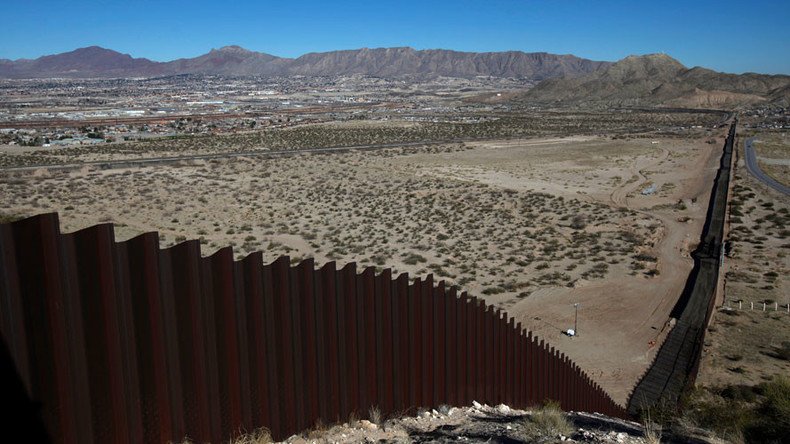Hundreds of companies bidding to ‘build that wall’ on US-Mexico border

The deadline for bids to build President Donald Trump’s “great, great wall” along the US border with Mexico has been extended, amid questions about how the $21.6 billion project will be funded and reports of legal challenges.
A federal database showed round 200 companies responded to the federal government’s two requests for proposals, one for a solid concrete border wall and two chain link fences, and another for wall design, according to the Washington Post.
Analysis: These Hispanic contractors offered to build Trump’s border wall. Then the death threats beganhttps://t.co/iq0yztdhFj
— Washington Post (@washingtonpost) March 29, 2017
The initial deadline for proposals was Wednesday, but Customs and Border Protection extended the deadline to April 4 and updated the solicitation with eight pages of questions and answers.
Among its specifics published on March 17, the government seeks a border wall between the US and Mexico that’s 30ft-tall of “concrete wall structures” with no maximum width or thickness, “physically imposing in height” with “anti-climb” features and “aesthetically pleasing” color on the north (US) side.
“The wall shall prevent digging or tunneling below it for a minimum of 6 feet below,” and “the wall shall prevent/deter for a minimum of 30 minutes, up to 4 hours, the creation of a physical breach of the wall (e.g. punching through the wall) larger than 12-inches in diameter or square using sledgehammer, car jack, pick axe, chisel, battery operate impacts tools, battery operated cutting tools, Oxy/acetylene torch or other similar hand-held tools.”
Architecural Digest: Looking at Trump's Quick Request for Border-Wall Plans https://t.co/r2RVuxobyX via @ArchDigest
— about:blank (@SOMAMadman) March 19, 2017
Following an initial elimination round, the remaining companies will be required to submit more detail technical proposals after which a group of finalists will be selected to convene in San Diego, California to construct both a 30ft-long prototype of their design. In addition, contending firms will have to construct a 10ft by 10ft “mock up” that will be used by the government to “test and evaluate the anti-destruct characteristics” of the design.
Integrated Security Corporation was interested in submitting a proposal for the two chain-link fences. Matt Kaye described his concept to the Guardian as a “typical correctional type fence" and said it would be “far less expensive and far less intrusive” than a concrete wall.
Liz Derr, founder and CEO of artificial intelligence company Simularity, is proposing an “invisible or virtual wall” using AI software to analyze satellite and surveillance imagery to identify unusual activity.
Kalmar Rough Terrain Center proposed using shipping containers.
“That is a very reasonable way to build a wall,” Steve Speakes told the Guardian, adding there was a surplus of containers due to a slowdown in global commerce.
Among 32 Latino-owned companies submitting proposals is the Pena Group, from Fort Worth, Texas which has carried out many large-scale federal projects.
“There are two different options. There’s a concrete wall that the government wants that is 30 foot high and has a 6-foot footing, and that has anti-tamper and anti-climb features. So we have several different options that meet what the government is wanting in terms of security,” Michael Evangelista Ysasaga told NPR. “At the same time, it is a very humane obstruction. I didn’t want to wake up on a Sunday morning and read about a dozen Guatemalan kids that were electrocuted or seriously injured that would not have been something that my consciousness would have allowed.”
Ysasaga is the grandson of immigrants that came to the US illegally and even many of his relatives are not in the US legally.
To build or not to build: Border wall funding may force government shutdown https://t.co/Xvp2mCWzSRpic.twitter.com/lwTbfVX1EI
— RT America (@RT_America) March 29, 2017
The Washington Post found that among the Latino-owned construction companies tendering proposals, many have been accused of betraying their community and some have received death threats. The companies told the Post they weighed their misgiving about the building the border wall against the benefits of providing jobs and growing their businesses.
“I try to be politically neutral in my decision-making process,” Al Anderson, general manager of KWR Construction, a Hispanic-owned firm in Sierra Vista, Arizona told the Washington Post. KWR Construction helped to build the border fence as well as related roads and lighting. “We want whatever jobs here along the border that we can get, and set aside our personal beliefs to support our employees.”
Anderson said if his company is selected, he expects some of his construction crew to quit rather than build the wall. “We’ll have people who are conscientious objectors against this particular project,” he said. “They live in a small community and they don’t want to get threatening calls in the middle of the night.”
‘Physically imposing & aesthetically pleasing’: #US border agency outlines #Mexico wall requirements https://t.co/4txOuzHTKw#Mexicowallpic.twitter.com/pcdmjVfzTm
— RT America (@RT_America) March 19, 2017
The Department of Homeland Security has estimated the 1,000-mile wall would cost $21.6 billion, nearly double of what Trump’s campaign has cited.
Trump first budget proposal to Congress, a preliminary draft, asked lawmakers for a $2.6 billion down payment for the wall. Congressional Republicans have estimated a more moderate price tag of $12 billion to $15 billion.
Apart from the cost of the wall, the geography where the wall will be built has treaty limitations. A 1970 treaty with Mexico requires that anything built near the Rio Grande river not obstruct its flow, and the same treaty rules apply to where the Colorado River flows on the border in Arizona.
There are also environmental regulations over what can be built and where — such as sensitive dunes in California that require a “floating fence” to allow for the natural movement of sand. There are also legal challenges. Nearly all the land along the Texas border is privately owned and buying it won’t be easy, according to AP.












